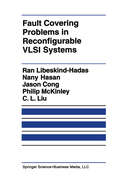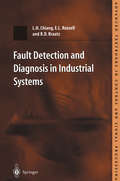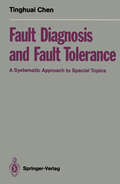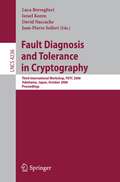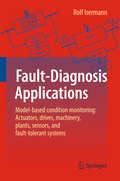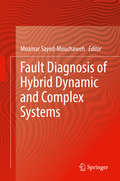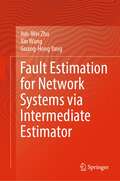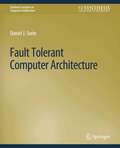- Table View
- List View
Fatal System Error: The Hunt for the New Crime Lords Who Are Bringing Down the Internet
by Joseph MennIn 2004, a California computer whiz named Barrett Lyon uncovered the identity of a hacker running major assaults on business websites. Without fully grasping the repercussions, he set on an investigation that led him into the heart of the Russian mob. Cybercrime was evolving. No longer the domain of small-time thieves, it had been discovered by sophisticated gangs. They began by attacking corporate websites but increasingly stole financial data from consumers and defense secrets from governments. While Barrett investigated the cutting edge of technology crime, the U.S. government struggled to catch up. Britain, however, was a different story. In the late 1990s, the Queen herself had declared safe e-commerce a national security priority. Agents from the London-based National Hi-Tech Crime Unit sought out Barrett and enlisted his help. They also sent detective Andrew Crocker, a Welsh former boxer, to Russia to track down and prosecute the hackers -- and to find out who they worked for.Fatal System Error penetrates both the Russian cyber-mob and the American mafia as the two fight over the Internet's massive spoils. It takes readers into the murky hacker underground, traveling the globe from San Francisco to Costa Rica, London, and Russia. Using unprecedented access to mob businesses and Russian officials, it shows how top criminals earned protection from the Russian government -- and how Barrett Lyon and Andrew Crocker got closer to the titans of the underground economy than any previous outsider. Together, their stories explain why cybercrime is much worse than you thought -- and why the Internet might not survive.
Fathom 2: Eine Einführung
by Rolf Biehler Tobias Hofmann Carmen Maxara Andreas PrömmelFathom 2 ist eine einzigartige dynamische Stochastik- und Datenanalysesoftware, die den besonderen Bedürfnissen der schulischen und universitären Lehre gerecht wird und die hier erstmals in deutscher Adaption vorgelegt wird. Die Einführung in Fathom 2 bietet einen schnellen und erfolgreichen Einstieg in diese Werkzeugsoftware anhand zahlreicher Beispiele zur statistischen Datenanalyse, zur stochastischen Simulation und zu mathematischen Aspekten der Stochastik. Exemplarisch wird weiterhin aufgezeigt, wie man mit Fathom interaktiv-explorative Arbeitsumgebungen für das Lehren und Lernen herstellen kann. Authentische Beispiele mit realen Daten, interaktive Erkundungen stochastischer Modelle und statistischer Methoden lassen sich so leichter in die einführende Statistikausbildung und den schulischen Stochastikunterricht integrieren. Mit einer einzigen flexiblen Werkzeugsoftware kann sowohl das Anwenden als auch das Lernen von Stochastik und Datenanalyse unterstützt werden. Das sehr nutzerfreundliche Interface sowie die wichtigsten graphischen und analytischen Tools werden vorgestellt und ausführlich beschrieben. In die Einführung sind mehrjährige Erfahrungen mit dem Einsatz von Fathom in der Lehre am Fachbereich Mathematik/Informatik der Universität Kassel und an mehreren Versuchsschulen eingegangen.
Fault Analysis in Cryptography (Information Security and Cryptography)
by Marc Joye Michael TunstallIn the 1970s researchers noticed that radioactive particles produced by elements naturally present in packaging material could cause bits to flip in sensitive areas of electronic chips. Research into the effect of cosmic rays on semiconductors, an area of particular interest in the aerospace industry, led to methods of hardening electronic devices designed for harsh environments. Ultimately various mechanisms for fault creation and propagation were discovered, and in particular it was noted that many cryptographic algorithms succumb to so-called fault attacks.Preventing fault attacks without sacrificing performance is nontrivial and this is the subject of this book. Part I deals with side-channel analysis and its relevance to fault attacks. The chapters in Part II cover fault analysis in secret key cryptography, with chapters on block ciphers, fault analysis of DES and AES, countermeasures for symmetric-key ciphers, and countermeasures against attacks on AES. Part III deals with fault analysis in public key cryptography, with chapters dedicated to classical RSA and RSA-CRT implementations, elliptic curve cryptosystems and countermeasures using fault detection, devices resilient to fault injection attacks, lattice-based fault attacks on signatures, and fault attacks on pairing-based cryptography. Part IV examines fault attacks on stream ciphers and how faults interact with countermeasures used to prevent power analysis attacks. Finally, Part V contains chapters that explain how fault attacks are implemented, with chapters on fault injection technologies for microprocessors, and fault injection and key retrieval experiments on a widely used evaluation board.This is the first book on this topic and will be of interest to researchers and practitioners engaged with cryptographic engineering.
Fault Covering Problems in Reconfigurable VLSI Systems (The Springer International Series in Engineering and Computer Science #172)
by Ran Libeskind-Hadas Nany Hasan Jingsheng Jason Cong Philip McKinley C.L. LiuFault Covering Problems in Reconfigurable VLSI Systems describes the authors' recent research on reconfiguration problems for fault-tolerance in VLSI and WSI Systems. The book examines solutions to a number of reconfiguration problems. Efficient algorithms are given for tractable covering problems and general techniques are given for dealing with a large number of intractable covering problems. The book begins with an investigation of algorithms for the reconfiguration of large redundant memories. Next, a number of more general covering problems are considered and the complexity of these problems is analyzed. Finally, a general and uniform approach is proposed for solving a wide class of covering problems. The results and techniques described here will be useful to researchers and students working in this area. As such, the book serves as an excellent reference and may be used as the text for an advanced course on the topic.
Fault Detection and Diagnosis in Industrial Systems (Advanced Textbooks in Control and Signal Processing)
by L.H. Chiang E.L. Russell R.D. BraatzEarly and accurate fault detection and diagnosis for modern chemical plants can minimize downtime, increase the safety of plant operations, and reduce manufacturing costs. This book presents the theoretical background and practical techniques for data-driven process monitoring. It demonstrates the application of all the data-driven process monitoring techniques to the Tennessee Eastman plant simulator, and looks at the strengths and weaknesses of each approach in detail. A plant simulator and problems allow readers to apply process monitoring techniques.
Fault Diagnosis: Models, Artificial Intelligence, Applications
by Wojciech Cholewa Józef Korbicz Jan M. Koscielny Zdzislaw KowalczukThis comprehensive work presents the status and likely development of fault diagnosis, an emerging discipline of modern control engineering. It covers fundamentals of model-based fault diagnosis in a wide context, providing a good introduction to the theoretical foundation and many basic approaches of fault detection.
Fault Diagnosis and Fault Tolerance: A Systematic Approach to Special Topics
by Tinghuai ChenWith the rapid growth of integration scale of VLSI chips and the present need for reliable computers in space exploration, fault diagnosis and fault toleran ce have become more important than before, and hence reveal a lot of interest ing topics which attract many researchers to make a great number of contribu tions to this field. In recent years, many new and significant results have been achieved. A quick scan over the proceedings of the conferences on fault tolerant computing and design automation as well as on testing will convince the reader of that. But unfortunately these achievements have not been entire ly reflected in the textbooks, so that there seems to be a gap for the new researcher who already has the basic knowledge and wants to begin research in this area. As a remedy for this deficiency, this book is intended for begin ners, especially graduate students, as a textbook which will lead them to the frontier of some branches of the fault-tolerant computing field. The first chapter introduces the four-valued logic B4 and its applica tions. In 1966 Roth first proposed this four-valued logic as a technique to generate tests for logical circuits, but this work did not concern the mathe matical basis of B4 itself.
Fault Diagnosis and Fault Tolerance for Mechatronic Systems: Recent Advances (Springer Tracts in Advanced Robotics #1)
by Fabrizio Caccavale Luigi VillaniThis book will play a central role in ensuring safe and reliable behaviour of intelligent and autonomous systems. It collects some of the most recent results in fault diagnosis and fault tolerant systems, with particular emphasis on mechatronic systems.
Fault Diagnosis and Fault-Tolerant Control Strategies for Non-Linear Systems: Analytical and Soft Computing Approaches (Lecture Notes in Electrical Engineering #266)
by Marcin WitczakThis book presents selected fault diagnosis and fault-tolerant control strategies for non-linear systems in a unified framework. In particular, starting from advanced state estimation strategies up to modern soft computing, the discrete-time description of the system is employed Part I of the book presents original research results regarding state estimation and neural networks for robust fault diagnosis. Part II is devoted to the presentation of integrated fault diagnosis and fault-tolerant systems. It starts with a general fault-tolerant control framework, which is then extended by introducing robustness with respect to various uncertainties. Finally, it is shown how to implement the proposed framework for fuzzy systems described by the well-known Takagi–Sugeno models.This research monograph is intended for researchers, engineers, and advanced postgraduate students in control and electrical engineering, computer science, as well as mechanical and chemical engineering.
Fault Diagnosis and Tolerance in Cryptography: Third International Workshop, FDTC 2006, Yokohama, Japan, October 10, 2006, Proceedings (Lecture Notes in Computer Science #4236)
by Luca Breveglieri Israel Koren David Naccache Jean-Pierre SeifertThis book constitutes the refereed proceedings of the Third International Workshop on Fault Diagnosis and Tolerance in Cryptography, FDTC 2006, held in Yokohama, Japan in October 2006. The 12 revised papers of FDTC 2006 are presented together with nine papers from FDTC 2004 and FDTC 2005 that passed a second round of reviewing. They all provide a comprehensive introduction to the issues faced by designers of robust cryptographic devices.
Fault-Diagnosis Applications: Model-Based Condition Monitoring: Actuators, Drives, Machinery, Plants, Sensors, and Fault-tolerant Systems
by Rolf IsermannSupervision, condition-monitoring, fault detection, fault diagnosis and fault management play an increasing role for technical processes and vehicles in order to improve reliability, availability, maintenance and lifetime. For safety-related processes fault-tolerant systems with redundancy are required in order to reach comprehensive system integrity. This book is a sequel of the book “Fault-Diagnosis Systems” published in 2006, where the basic methods were described. After a short introduction into fault-detection and fault-diagnosis methods the book shows how these methods can be applied for a selection of 20 real technical components and processes as examples, such as: Electrical drives (DC, AC)Electrical actuatorsFluidic actuators (hydraulic, pneumatic)Centrifugal and reciprocating pumpsPipelines (leak detection)Industrial robotsMachine tools (main and feed drive, drilling, milling, grinding)Heat exchangers Also realized fault-tolerant systems for electrical drives, actuators and sensors are presented. The book describes why and how the various signal-model-based and process-model-based methods were applied and which experimental results could be achieved. In several cases a combination of different methods was most successful. The book is dedicated to graduate students of electrical, mechanical, chemical engineering and computer science and for engineers.
Fault Diagnosis Inverse Problems: Solution with Metaheuristics (Studies in Computational Intelligence #763)
by Lídice Camps Echevarría Orestes Llanes Santiago Haroldo Fraga Campos Velho Antônio José Silva NetoThis book presents a methodology based on inverse problems for use in solutions for fault diagnosis in control systems, combining tools from mathematics, physics, computational and mathematical modeling, optimization and computational intelligence. This methodology, known as fault diagnosis – inverse problem methodology or FD-IPM, unifies the results of several years of work of the authors in the fields of fault detection and isolation (FDI), inverse problems and optimization. The book clearly and systematically presents the main ideas, concepts and results obtained in recent years. By formulating fault diagnosis as an inverse problem, and by solving it using metaheuristics, the authors offer researchers and students a fresh, interdisciplinary perspective for problem solving in these fields. Graduate courses in engineering, applied mathematics and computing also benefit from this work.
Fault Diagnosis of Hybrid Dynamic and Complex Systems
by Moamar Sayed-MouchawehOnline fault diagnosis is crucial to ensure safe operation of complex dynamic systems in spite of faults affecting the system behaviors. Consequences of the occurrence of faults can be severe and result in human casualties, environmentally harmful emissions, high repair costs, and economical losses caused by unexpected stops in production lines. The majority of real systems are hybrid dynamic systems (HDS). In HDS, the dynamical behaviors evolve continuously with time according to the discrete mode (configuration) in which the system is. Consequently, fault diagnosis approaches must take into account both discrete and continuous dynamics as well as the interactions between them in order to perform correct fault diagnosis. This book presents recent and advanced approaches and techniques that address the complex problem of fault diagnosis of hybrid dynamic and complex systems using different model-based and data-driven approaches in different application domains (inductor motors, chemical process formed by tanks, reactors and valves, ignition engine, sewer networks, mobile robots, planetary rover prototype etc.). These approaches cover the different aspects of performing single/multiple online/offline parametric/discrete abrupt/tear and wear fault diagnosis in incremental/non-incremental manner, using different modeling tools (hybrid automata, hybrid Petri nets, hybrid bond graphs, extended Kalman filter etc.) for different classes of hybrid dynamic and complex systems.
Fault Estimation for Network Systems via Intermediate Estimator
by Jun-Wei Zhu Xin Wang Guang-Hong YangThis book is concerned with the fault estimation problem for network systems. Firstly, to improve the existing adaptive fault estimation observer, a novel so-called intermediate estimator is proposed to identify the actuator or sensor faults in dynamic control systems with high accuracy and convergence speed. On this basis, by exploiting the properties of network systems such as multi-agent systems and large-scale interconnected systems, this book introduces the concept of distributed intermediate estimator; faults in different nodes can be estimated simultaneously; meanwhile, satisfactory consensus performances can be obtained via compensation based protocols. Finally, the characteristics of the new fault estimation methodology are verified and discussed by a series of experimental results on networked multi-axis motion control systems. This book can be used as a reference book for researcher and designer in the field of fault diagnosis and fault-tolerant control and can also be used as a reference book for senior undergraduate and graduate students in colleges and universities.
Fault Injection Techniques and Tools for Embedded Systems Reliability Evaluation (Frontiers in Electronic Testing #23)
by Alfredo Benso Paolo PrinettoThis is a comprehensive guide to fault injection techniques used to evaluate the dependability of a digital system. The description and the critical analysis of different fault injection techniques and tools are authored by key scientists in the field of system dependability and fault tolerance.
Fault Location on Power Networks (Power Systems)
by Murari Mohan Saha Jan Jozef Izykowski Eugeniusz RosolowskiFault Location on Power Lines enables readers to pinpoint the location of a fault on power lines following a disturbance. The nine chapters are organised according to the design of different locators. The authors do not simply refer the reader to manufacturers’ documentation, but instead have compiled detailed information to allow for in-depth comparison. Fault Location on Power Lines describes basic algorithms used in fault locators, focusing on fault location on overhead transmission lines, but also covering fault location in distribution networks. An application of artificial intelligence in this field is also presented, to help the reader to understand all aspects of fault location on overhead lines, including both the design and application standpoints. Professional engineers, researchers, and postgraduate and undergraduate students will find Fault Location on Power Lines a valuable resource, which enables them to reproduce complete algorithms of digital fault locators in their basic forms.
Fault Prediction Modeling for the Prediction of Number of Software Faults (SpringerBriefs in Computer Science)
by Santosh Singh Rathore Sandeep KumarThis book addresses software faults—a critical issue that not only reduces the quality of software, but also increases their development costs. Various models for predicting the fault-proneness of software systems have been proposed; however, most of them provide inadequate information, limiting their effectiveness. This book focuses on the prediction of number of faults in software modules, and provides readers with essential insights into the generalized architecture, different techniques, and state-of-the art literature. In addition, it covers various software fault datasets and issues that crop up when predicting number of faults. A must-read for readers seeking a “one-stop” source of information on software fault prediction and recent research trends, the book will especially benefit those interested in pursuing research in this area. At the same time, it will provide experienced researchers with a valuable summary of the latest developments.
Fault Tolerance: Principles and Practice (Dependable Computing and Fault-Tolerant Systems #3)
by Peter A. Lee Thomas AndersonThe production of a new version of any book is a daunting task, as many authors will recognise. In the field of computer science, the task is made even more daunting by the speed with which the subject and its supporting technology move forward. Since the publication of the first edition of this book in 1981 much research has been conducted, and many papers have been written, on the subject of fault tolerance. Our aim then was to present for the first time the principles of fault tolerance together with current practice to illustrate those principles. We believe that the principles have (so far) stood the test of time and are as appropriate today as they were in 1981. Much work on the practical applications of fault tolerance has been undertaken, and techniques have been developed for ever more complex situations, such as those required for distributed systems. Nevertheless, the basic principles remain the same.
Fault-Tolerance Techniques for High-Performance Computing (Computer Communications and Networks)
by Thomas Herault Yves RobertThis timely text presents a comprehensive overview of fault tolerance techniques for high-performance computing (HPC). The text opens with a detailed introduction to the concepts of checkpoint protocols and scheduling algorithms, prediction, replication, silent error detection and correction, together with some application-specific techniques such as ABFT. Emphasis is placed on analytical performance models. This is then followed by a review of general-purpose techniques, including several checkpoint and rollback recovery protocols. Relevant execution scenarios are also evaluated and compared through quantitative models. Features: provides a survey of resilience methods and performance models; examines the various sources for errors and faults in large-scale systems; reviews the spectrum of techniques that can be applied to design a fault-tolerant MPI; investigates different approaches to replication; discusses the challenge of energy consumption of fault-tolerance methods in extreme-scale systems.
Fault-Tolerance Techniques for Spacecraft Control Computers
by Mengfei Yang Gengxin Hua Yanjun Feng Jian GongComprehensive coverage of all aspects of space application oriented fault tolerance techniques • Experienced expert author working on fault tolerance for Chinese space program for almost three decades• Initiatively provides a systematic texts for the cutting-edge fault tolerance techniques in spacecraft control computer, with emphasis on practical engineering knowledge• Presents fundamental and advanced theories and technologies in a logical and easy-to-understand manner• Beneficial to readers inside and outside the area of space applications
Fault-Tolerance Techniques for Spacecraft Control Computers
by Mengfei Yang Gengxin Hua Yanjun Feng Jian GongComprehensive coverage of all aspects of space application oriented fault tolerance techniques • Experienced expert author working on fault tolerance for Chinese space program for almost three decades• Initiatively provides a systematic texts for the cutting-edge fault tolerance techniques in spacecraft control computer, with emphasis on practical engineering knowledge• Presents fundamental and advanced theories and technologies in a logical and easy-to-understand manner• Beneficial to readers inside and outside the area of space applications
Fault-Tolerance Techniques for SRAM-Based FPGAs (Frontiers in Electronic Testing #32)
by Fernanda Lima Kastensmidt Ricardo ReisThis book reviews fault-tolerance techniques for SRAM-based Field Programmable Gate Arrays (FPGAs), outlining many methods for designing fault tolerance systems. Some of these are based on new fault-tolerant architecture, and others on protecting the high-level hardware description before synthesis in the FPGA. The text helps the reader choose the best techniques project-by-project, and to compare fault tolerant techniques for programmable logic applications.
Fault-tolerant Agreement in Synchronous Message-passing Systems (Synthesis Lectures on Distributed Computing Theory)
by Michel RaynalUnderstanding distributed computing is not an easy task. This is due to the many facets of uncertainty one has to cope with and master in order to produce correct distributed software. A previous book Communication and Agreement Abstraction for Fault-tolerant Asynchronous Distributed Systems (published by Morgan & Claypool, 2010) was devoted to the problems created by crash failures in asynchronous message-passing systems. The present book focuses on the way to cope with the uncertainty created by process failures (crash, omission failures and Byzantine behavior) in synchronous message-passing systems (i.e., systems whose progress is governed by the passage of time). To that end, the book considers fundamental problems that distributed synchronous processes have to solve. These fundamental problems concern agreement among processes (if processes are unable to agree in one way or another in presence of failures, no non-trivial problem can be solved). They are consensus, interactive consistency, k-set agreement and non-blocking atomic commit. Being able to solve these basic problems efficiently with provable guarantees allows applications designers to give a precise meaning to the words ""cooperate"" and ""agree"" despite failures, and write distributed synchronous programs with properties that can be stated and proved. Hence, the aim of the book is to present a comprehensive view of agreement problems, algorithms that solve them and associated computability bounds in synchronous message-passing distributed systems. Table of Contents: List of Figures / Synchronous Model, Failure Models, and Agreement Problems / Consensus and Interactive Consistency in the Crash Failure Model / Expedite Decision in the Crash Failure Model / Simultaneous Consensus Despite Crash Failures / From Consensus to k-Set Agreement / Non-Blocking Atomic Commit in Presence of Crash Failures / k-Set Agreement Despite Omission Failures / Consensus Despite Byzantine Failures / Byzantine Consensus in Enriched Models
Fault Tolerant Architectures for Cryptography and Hardware Security (Computer Architecture and Design Methodologies)
by Sikhar Patranabis Debdeep MukhopadhyayThis book uses motivating examples and real-life attack scenarios to introduce readers to the general concept of fault attacks in cryptography. It offers insights into how the fault tolerance theories developed in the book can actually be implemented, with a particular focus on a wide spectrum of fault models and practical fault injection techniques, ranging from simple, low-cost techniques to high-end equipment-based methods. It then individually examines fault attack vulnerabilities in symmetric, asymmetric and authenticated encryption systems. This is followed by extensive coverage of countermeasure techniques and fault tolerant architectures that attempt to thwart such vulnerabilities. Lastly, it presents a case study of a comprehensive FPGA-based fault tolerant architecture for AES-128, which brings together of a number of the fault tolerance techniques presented. It concludes with a discussion on how fault tolerance can be combined with side channel security to achieve protection against implementation-based attacks. The text is supported by illustrative diagrams, algorithms, tables and diagrams presenting real-world experimental results.
Fault Tolerant Computer Architecture (Synthesis Lectures on Computer Architecture)
by Daniel SorinFor many years, most computer architects have pursued one primary goal: performance. Architects have translated the ever-increasing abundance of ever-faster transistors provided by Moore's law into remarkable increases in performance. Recently, however, the bounty provided by Moore's law has been accompanied by several challenges that have arisen as devices have become smaller, including a decrease in dependability due to physical faults. In this book, we focus on the dependability challenge and the fault tolerance solutions that architects are developing to overcome it. The two main purposes of this book are to explore the key ideas in fault-tolerant computer architecture and to present the current state-of-the-art - over approximately the past 10 years - in academia and industry. Table of Contents: Introduction / Error Detection / Error Recovery / Diagnosis / Self-Repair / The Future



